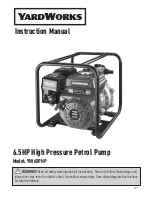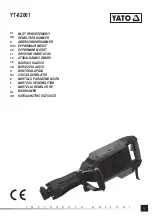
8
GENERAL SAFETY INSTRUCTIONS
1) WORK AREA
a) Do not operate pump in explosive atmospheres, such as in the presence of flammable liquids, gases
or dust.
Engine may create sparks which may ignite the dust or fumes.
b) Never run engine in an enclosed area. Exhaust gases contain deadly, poisonous carbon monoxide,
which has no odor or taste.
Exposure may cause loss of consciousness and may lead to death.
c) Keep by-standers, children and visitors away while installing pump.
Distractions can result in mistakes.
d) Keep the engine at least 1 meter (3 feet) away from buildings and other equipment during
operation. Do not place flammable objects close to the engine.
Procedure should be followed to prevent
fire hazards and to provide adequate ventilation.
2) PERSONAL SAFETY
a) Stay alert, watch what you are doing and use common sense when operating this pump. Do not
attempt to use pump while tired or under the influence of drugs, alcohol or medications.
A moment of
inattention while operating power tools may result in serious personal injury.
b) Dress appropriately. Do not wear loose clothing or jewelry. Contain long hair. Keep your hair, clothing
and gloves away from moving parts.
Loose clothes, jewelry or long hair can be caught in moving parts.
c) Do not overreach. Keep proper footing and balance at all times.
Proper footing and balance enables better
control of the pump in unexpected situations.
d) Use safety equipment.
Always wear eye protection. Dust mask, non-skid safety shoes and hard hat must be
used for appropriate conditions.
3) PUMP USE AND CARE
a) Store idle pump out of reach of children and other untrained persons.
Pumps are dangerous in the hands
of untrained users.
b) Maintain pump. Keep hoses in proper operating condition.
Properly maintained pumps are less likely to
malfunction and cause injury.
c) Check for misalignment or binding of moving parts, breakage of parts and any other condition that
may affect the pumps operation.
If damaged, have the pump serviced before using. Accidents can be caused
by poorly maintained pumps.
d) Always shut off the engine, allow the engine to cool and remove the spark plug before performing any
maintenance.
Such preventative measures reduce the risk of starting the pump accidentally.
e) Keep handles dry and clean; free from oil and grease.
Allows for better control of the pump.
4) SERVICE
a) Pump service must be performed only by qualified repair personnel.
Service or maintenance performed by
unqualified repair personnel could result in injury.
b) When servicing a pump, use only identical replacement parts. Follow instructions in the Maintenance
Section of this manual.
Use of unauthorized parts or failure to follow maintenance instructions may create a
risk of injury and may void your warranty.





































